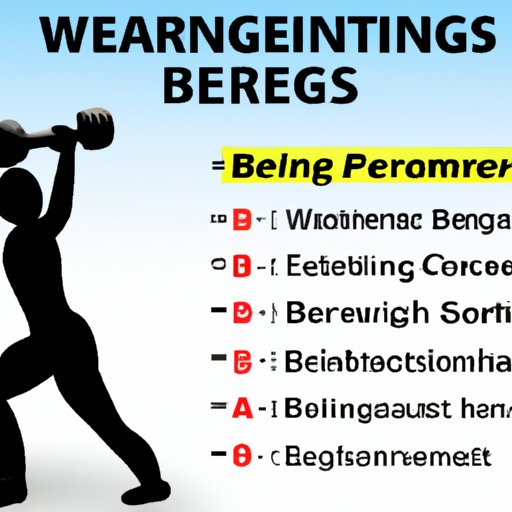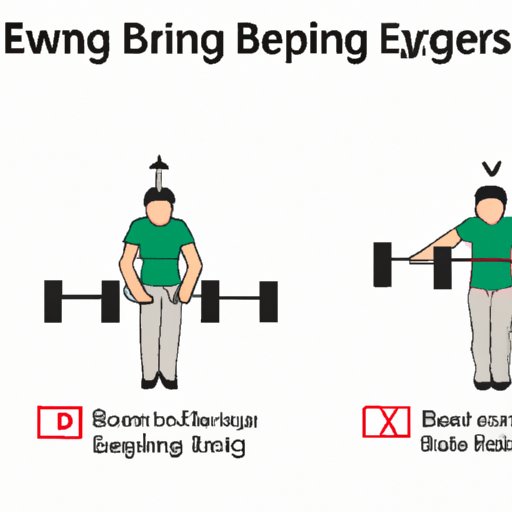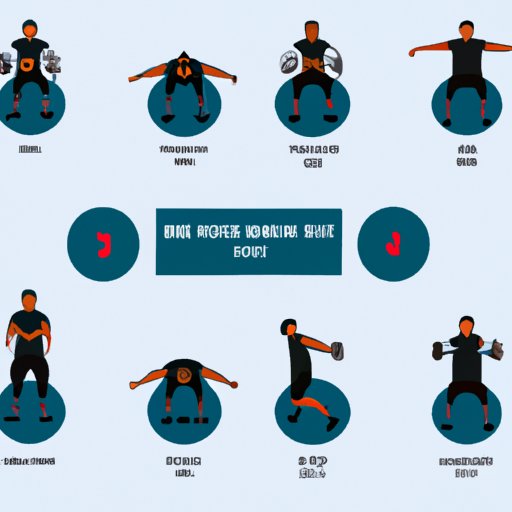Introduction
Weight bearing exercises are a type of resistance training that involve using your own body weight as a source of resistance. This type of exercise is often used in strength training and can help improve muscle strength, endurance, and flexibility. It can also be used to tone muscles and increase overall physical fitness. In this article, we’ll explore what weight bearing exercises are, the benefits they offer, and how to properly incorporate them into your workout routine.
What are Weight Bearing Exercises?
Weight bearing exercises are any type of exercise where you use your own body weight as a source of resistance. This includes exercises like squats, lunges, push-ups, deadlifts, step-ups, and shoulder presses. These exercises are considered weight bearing because they require the use of force against gravity to move your body and lift weights. While there are many different types of weight bearing exercises, they all share the same goal of strengthening and toning muscles.

Benefits of Weight Bearing Exercises
Weight bearing exercises offer a number of health benefits. According to a study published in the Journal of Sports Science and Medicine, weight bearing exercises can lead to increased muscular strength, endurance, and power. They can also help improve balance and coordination. Furthermore, weight bearing exercises can help improve bone density and reduce the risk of osteoporosis.
In addition to the physical benefits, weight bearing exercises can also have a positive effect on mental health. A study from the American Journal of Health Promotion found that weight bearing exercise was associated with improved mood and self-esteem. It can also lead to improved focus and concentration.
Popular Weight Bearing Exercises
There are a variety of weight bearing exercises that can be incorporated into a workout routine. Here are some of the most popular weight bearing exercises:
Squats
Squats are a great way to strengthen the lower body. To perform a squat, stand with your feet hip-width apart and your arms at your sides. Bend your knees and lower your body until your thighs are parallel to the floor. Hold for a few seconds and then push back up to the starting position.
Lunges
Lunges are another effective weight bearing exercise that targets the lower body. To perform a lunge, stand with your feet hip-width apart and your arms at your sides. Step forward with one leg and lower your body until both knees are bent at 90-degree angles. Hold for a few seconds and then push back up to the starting position.
Push-Ups
Push-ups are a great way to strengthen the upper body. To perform a push-up, start in a plank position with your hands directly under your shoulders and your feet hip-width apart. Lower your body until your chest touches the ground and then push back up to the starting position.
Deadlifts
Deadlifts target the entire body and are a great way to build strength. To perform a deadlift, stand with your feet hip-width apart and your arms by your sides. Bend your knees and hinge forward at the hips while keeping your back straight. Lift the weight off the floor and return to the starting position.
Step-Ups
Step-ups are a great way to strengthen the lower body. To perform a step-up, stand with your feet hip-width apart and your arms at your sides. Step up onto a platform or bench with one foot and then step back down with the other foot.
Shoulder Presses
Shoulder presses are a great way to strengthen the upper body. To perform a shoulder press, stand with your feet hip-width apart and your arms at your sides. Lift the weights up to shoulder height and then press them overhead. Lower the weights back to shoulder height and repeat.

How to Properly Perform Weight Bearing Exercises
When performing weight bearing exercises, it’s important to pay attention to technique, form, and breathing. Proper technique will help ensure that you’re targeting the right muscles and getting the most out of each exercise. Proper form will help you avoid injury and maximize results. And proper breathing will help you stay focused and maintain control of the movement.
Tips for Incorporating Weight Bearing Exercises into a Workout Routine
Incorporating weight bearing exercises into a workout routine can be beneficial for both physical and mental health. Here are some tips for incorporating weight bearing exercises into your routine:
Frequency
Aim to do weight bearing exercises two to three times a week. This will help ensure that you’re getting enough exercise to see results without overdoing it and risking injury.
Variety
Vary the exercises that you do. This will help keep your routine fresh and prevent boredom. It will also help ensure that you’re targeting different muscle groups for maximum benefit.
Intensity
Increase the intensity of your workouts gradually. Start with lighter weights and fewer reps and gradually increase as you become stronger. This will help ensure that you don’t overexert yourself and risk injury.

Safety Precautions When Doing Weight Bearing Exercises
It’s important to take safety precautions when doing weight bearing exercises. Here are some safety tips to keep in mind:
Warm Up
Always warm up before doing weight bearing exercises. This will help prepare your body for the workout and reduce the risk of injury.
Cool Down
After your workout, make sure to cool down. This will help your body recover and reduce the risk of soreness and injury.
Stretching
Make sure to stretch after your workout. Stretching will help reduce muscle tension and improve flexibility.
Increasing Intensity with Weight Bearing Exercises
Once you’ve mastered the basics of weight bearing exercises, you can increase the intensity of your workouts. Here are some ways to increase the intensity of your workouts:
Adding Weights
Adding weights to your workouts is a great way to increase the intensity. Make sure to start with lighter weights and gradually increase as you become stronger.
Adding Reps
You can also increase the intensity by adding more reps to your workouts. Start with fewer reps and gradually increase as you become stronger.
Changing Tempo
Changing the tempo of your exercises can also help increase the intensity. Try doing slower movements for more resistance or faster movements for more speed and agility.
Comparing Weight Bearing Exercises to Non-Weight Bearing Exercises
Weight bearing exercises are often compared to non-weight bearing exercises. While both types of exercises can be beneficial, there are some key differences between them. Here are some similarities and differences between weight bearing exercises and non-weight bearing exercises:
Similarities
Both weight bearing exercises and non-weight bearing exercises can help improve muscle strength, endurance, and flexibility. Both can also help improve balance and coordination.
Differences
The main difference between weight bearing exercises and non-weight bearing exercises is the use of gravity. Weight bearing exercises use gravity as a form of resistance, while non-weight bearing exercises do not. Weight bearing exercises can also help improve bone density, which non-weight bearing exercises cannot.
Conclusion
Weight bearing exercises are an important part of any workout routine. They can help strengthen and tone muscles, improve balance and coordination, and even boost mental health. When incorporating weight bearing exercises into your routine, make sure to pay attention to technique, form, and breathing. Also, remember to warm up, cool down, and stretch after your workouts. With these tips in mind, you can safely and effectively incorporate weight bearing exercises into your routine.
(Note: Is this article not meeting your expectations? Do you have knowledge or insights to share? Unlock new opportunities and expand your reach by joining our authors team. Click Registration to join us and share your expertise with our readers.)
